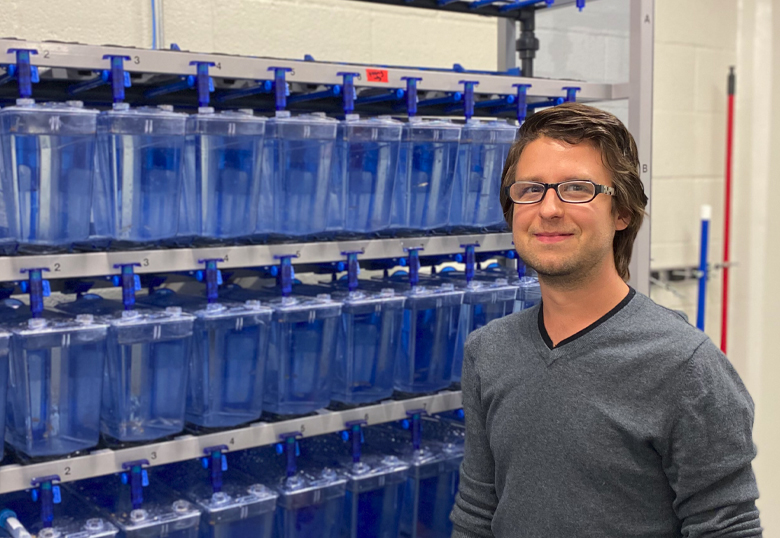Studying the impacts of chemical pollutants on fish reproduction in the field is a complicated business. Because complex environmental cues, such as changes in temperature, salinity and food availability, are all linked to reproduction, scientists at the University of Lethbridge are working on developing an easier way of monitoring fish species.
Using a blood, fin or scale sample that can be taken without harming the fish, researchers can determine if a particular species of fish is highly susceptible to a chemical exposure. They then can identify a need to monitor certain fish species or pinpoint certain areas of an aquatic system to monitor.

To get to that point, scientists like Dr. Jon Doering, the recipient of a Natural Sciences and Engineering Research Council (NSERC) post-doctoral fellowship, first work with fish in a controlled lab environment.
“These are typically small minnow-type fish that you can actually reproduce in an aquarium,” says Doering. “We look at the genetic and molecular mechanisms to extrapolate to large, native fish, like northern pike, trout and sturgeon, that we’re interested in for economic, ecological and cultural reasons.”
His work in Dr. Steve Wiseman’s lab in the Department of Biological Sciences aims to provide scientific evidence to direct conservation efforts in fish.
“Our primary goal is to determine the impacts of chemical pollutants on fish populations by extrapolating results from working on model fish in the lab, which aren’t necessarily native to Canada or of regulatory concern, to species that we are more interested in protecting, like recreational fishing species and endangered and threatened species,” says Doering. “We’re doing this through 21st century approaches and advances in predictive and molecular toxicology.”
Doering is looking at the long-term impacts on fish reproduction from chemical exposures in early life. Previous research has shown that a developing embryo exposed to a chemical for even a very brief time may have reproductive problems as an adult. Doering is specifically studying a class of chemicals known as polycyclic aromatic hydrocarbons. These ubiquitous chemicals are released in the burning of organic matter, such as forest fires or burning coal. They’re also found in oil and are released into the environment through vehicle exhaust, during oil extraction and refining, or an oil spill.
“Exposed fish might produce fewer eggs or no eggs at all,” says Doering. “This is something that’s very hard to measure in the field because the fish are otherwise perfectly healthy, they just can’t produce eggs due to a chemical impact very early on in life. We’re measuring this in a number of different species and looking at species differences in susceptibility to these impacts and then we’re developing molecular models to predict those impacts in native species that are important to Canadians, like northern pike, endangered sturgeon species and other recreational species.”
They’ve largely determined the molecular mechanisms involved in this process. Chemicals can bind to the aryl hydrocarbon receptor (AHR) in fish and can disrupt the processes that control the expression of different genes, causing certain reproductive genes to not be expressed at the proper levels.
“These disruptions can be permanent and they can actually be passed on to multiple generations, not just the individual that was exposed,” says Doering. “When expression disruptions happen, a fish that grows to adulthood is not expressing these reproductive genes at the proper levels and that’s what prevents it from producing eggs. This can lead to long-term population decreases.”
Doering and Wiseman suspect some species of fish are more sensitive because the structure of their receptor has a high affinity for these chemicals. Other species with a different receptor structure may be more tolerant of chemical exposures early in life.
“The idea is that we can predict a species sensitivity based on how tightly those chemicals bind to that receptor, and we can assess that interaction without having to kill any fish,” says Doering. “In an endangered species for instance, we can collect a blood sample, a scale or a fin clip and we can do all the measurements we need. That could inform what species we want to monitor.”
Doering completed his PhD at the University of Saskatchewan and worked as a postdoctoral fellow with the United States Environmental Protection Agency on the Great Lakes Restoration Project before joining the U of L. His NSERC post-doctoral fellowship is the second for the University.
